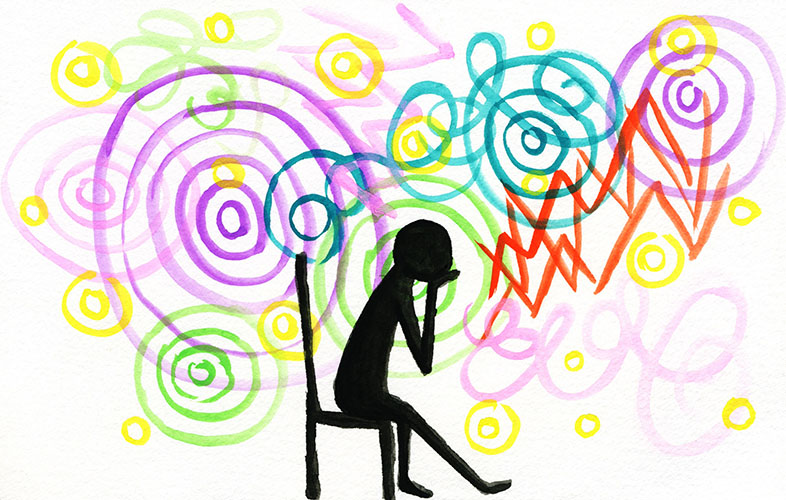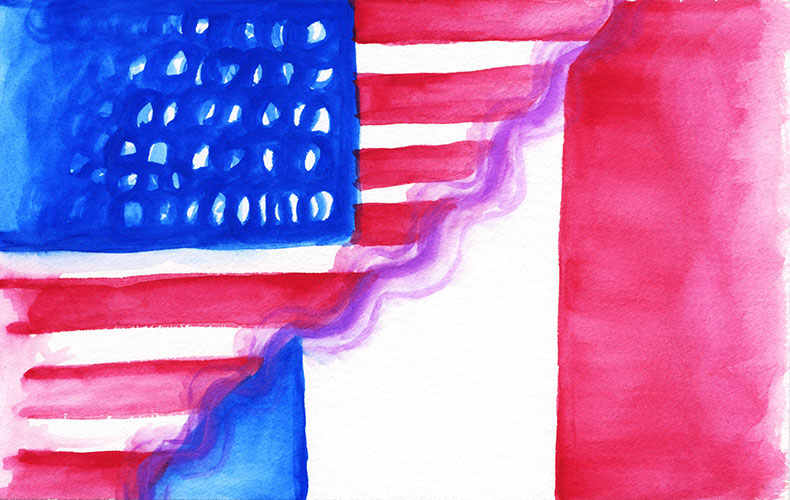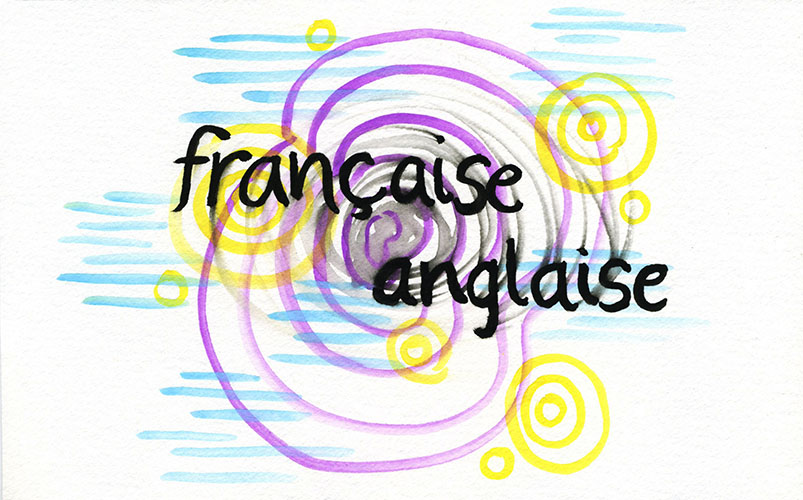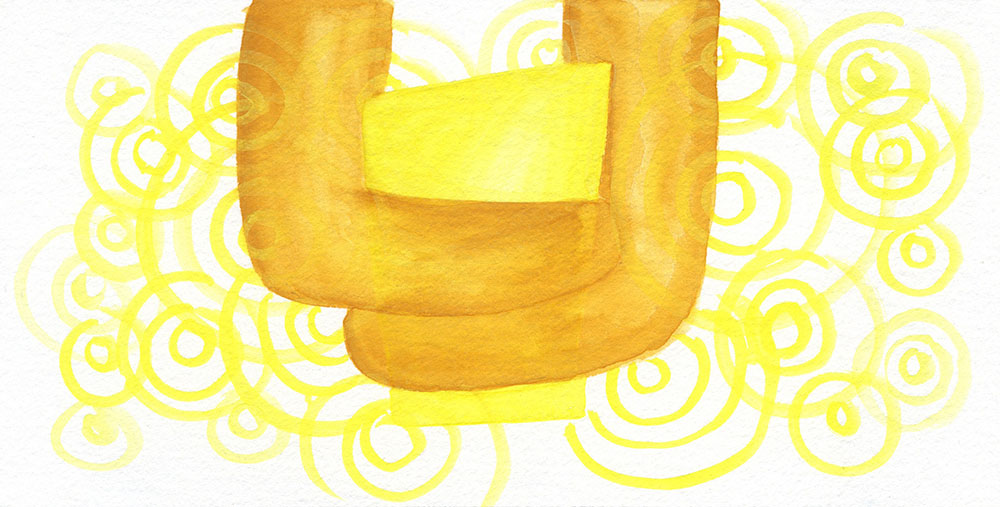We were driving through Al Hasa and I had in my hands a battered copy of Jack Kerouac’s The Dharma Bums. The cover was bright yellow, like I was holding a piece of sunlight. As we sped through the oasis and its dense rows of palm trees and crisscrossing irrigation troughs, I read. I was in middle-school and more interested in science fiction than anything else, but the prose of this book tumbled like poetry and I was captivated. There was a restlessness within the writing, a tender longing for something just out of reach, that resonated with me in a way I did not yet entirely understand.
As an American born and raised in the Arabian Gulf prior to the widespread availability of internet and satellite TV, my childhood was cut off from many aspects of American life. This was reinforced by the fact that my parents had likewise grown up in the Gulf and found themselves similarly distanced from our passport country. This meant that I read the few copies of Kerouac’s books my family owned not fully aware of the author’s status as a pop culture icon, of the way his image was – much to his dismay – used as shorthand to signify a kind of shallow and inchoate youthful rebellion.
It was when I left home to attend university in the United States that I had my first formal exposure to the way Kerouac’s work is often received by the literary establishment. I was surprised at the way his writing was casually dismissed by those with scholarly leanings, and by the way much of the vitriol directed toward him seemed to focus on his persona, rather than a critique of his work and the impact it had at the time it was written. In class, professors offered pinched smiles when his name was mentioned, while students spoke over one another to list the reasons why Kerouac could never be considered ‘real literature’. Usually, the kindest concession granted was to condescendingly say that while he was not a good writer, he had been an influential figure. To this day, whenever an article about Kerouac goes viral, in the comments I see the same attitude expressed. More than other authors of his generation, it seems that Kerouac is still capable of eliciting heated displays of emotion, of making normally level-headed people type in all caps or proclaim that they refuse to date anyone who owns a copy of On the Road. It is even said that one should grow out of their love of Kerouac by high-school at the latest, and a continuing affection for him beyond that point is viewed as an embarrassing affliction.
As I became aware of the extent and tenacity of the Kerouac persona, I was puzzled. While there is room for debate on how closely Kerouac’s narrators – such as Sal Paradise, Jack Duluoz, and Ray Smith – hewed to the reality of the author himself, they all depict men who are introspective, lonely, and beset with insecurity. That they could be viewed as dim-witted, macho renegades just out for a good time is absurd. Kerouac’s writing is replete with references that make apparent his devoted study of literature, and at its core his work grapples with the fundamental questions of life, of how we – as imperfect human beings – can live lives of meaning in a world fraught with pain. Here is a writer overcome with the intensity of his emotions, who wrestles with metaphysical dilemmas and proclaims in lush language a wild love for his friends, strangers, even God, doing so with an earnestness that was not seen as befitting a man of his era. As Aram Saroyan wrote in his foreword to Kerouac’s Big Sur, Kerouac dared to set down in prose his “series of long, tender nervous breakdowns”, and in so doing challenged his era’s rigid conception of masculinity.

What I saw so often in those university discussions and still see in the Kerouac articles published to this day is a tendency observed by Ihab Hassan, that readers often respond to an author’s reputation while pretending – or perhaps even believing – that their response is to the writing itself. While Kerouac did contribute to the cultivation of the legend that surrounds him, sometimes downplaying the exacting and methodical rounds of writing and rewriting he engaged in to foreground the freewheeling, naturalistic outpouring of expression, looking back it is clear that in the public’s mind his persona took on a life of its own and caused him tremendous misery by undermining the literary merits of his work. Eventually, Kerouac’s image as the poster boy of non-conformist rebellion grew so colossal that it eclipsed the actual Kerouac and his writing, ultimately supplanting completely the work with the myth. This obfuscation led John Clellon Holmes to refer to Kerouac’s work as “a best kept secret.”
During my years in the US, in addition to catching up on all the pop culture references I had missed during my childhood, like the jarring extent of Kerouac’s persona, I also experienced a long-lasting, disorienting sense of culture shock. As an American finally living in America, I waited to feel a sense of belonging but I only felt an increasing awareness of being perpetually out of place. In time, I learned that this feeling was common among transcultural individuals; in the adult third culture kid community the term ‘hidden immigrant’ is used to describe people who find that the experience of living in their passport country provokes a distressing dissonance between their self-conception and the way they are perceived by others. After graduation I was relieved to return home to the Gulf, and while it’s now been more than 12 years since I was last in the United States, I can still remember the surreal feeling of the time I spent there. This experience led to Kerouac’s writing resonating differently with me as an adult, and when I moved beyond his pop culture persona to learn more about his life, it was a revelation to discover just how deeply his own transcultural identity impacted his work.
Born in 1922 in Lowell, Massachusetts to French-Canadian parents, Kerouac grew up caught between two worlds. In the face of prejudice from the wider Anglo-Saxon Protestant community, the close-knit French-Canadian diaspora was determined to keep alive their particular traditions and language. Kerouac grew up speaking French and did not learn English until he was 6 years old, and then he spoke the language with an accent well into his teenage years. As a child, Kerouac would have learned about the French-Canadian diaspora’s arduous migration to America and would have been keenly aware that he belonged to a minority community that faced contempt and discrimination. At the same time, he was fascinated by the country of his birth, intrigued by its mythos and history. In a letter to a friend in 1947, Kerouac wrote, “My subject as a writer is of course America and I simply must know everything about it.” This focus would remain a constant throughout his entire body of work, which continually wrestles with what the nation means and, indeed, what it means to be an American. Kerouac’s complicated feelings toward the United States included a nostalgic belief that a return to a rugged, individualistic American spirit could rectify the conformist middle-class mentality he felt stifled by, but this idealistic love was tempered by a feeling that he could never quite shake of being a perpetual outsider. Transcultural individuals often exist in uneasy relation to their ‘home’ country, fascinated and frustrated in turn, an ambivalence born of their dualistic insider/outsider status. Kerouac captured this sentiment when he referred to himself as “half-American” and as a “North American exile in North America.” Kerouac’s struggle to make a cohesive whole out of the split identity that often tormented him was never successful, and he would spend his life writing about America from the perspective of a native-born outsider. As Kerouac biographer and friend Joyce Johnson wrote in her book The Voice is All: The Lonely Victory of Jack Kerouac, “For Jack, whose attachment to his heritage was as strong as it was anguished, the process of becoming American would never be completed, and it would be particularly wrenching” (23).

In discussions of Kerouac’s work from a contemporary vantage point, it frequently passes without note that during his life, and especially during his youth, he would have acutely understood that his background set him apart from mainstream culture and that this understanding played a crucial role in his work as a writer. However, in recent years there have been an increasing number of critical approaches to Kerouac’s writing that take into account the influence of his transcultural identity and seek to redress the shallow appraisals his oeuvre has often been subjected to. In Hassan Melehy’s Kerouac: Language, Poetics, and Territory, Kerouac’s status as “an outsider to the English language and dominant American culture (15)” is explored, as is the importance of Kerouac’s own “conception of how cultures and languages work: as a set of contacts and exchanges that never ceases its migrations and transformations” (15). In Melehy’s study, it becomes clear that Kerouac’s iconoclastic writing was carefully calibrated to transgress borders between fiction and memoir, English and French, poetry and prose, periphery and center, in ways that foreshadowed the profusion of American post-modern writing in the latter half of the 20th century. By crossing these borders, Kerouac’s writing calls into question rigid norms and hierarchical power structures in a way that makes space for the inclusion of different modes of being. Melehy believes the narrative in On the Road regularly “presents travel that goes to the limits of dominant white culture in America, by both exposing ethnic and cultural heterogeneity within the United States and staging a confrontation between the dominant culture and one that is radically other” (58).
While Kerouac gave prominence in his writing to communities and cultures not typically included in the mainstream literature of the era, he is often criticized for doing so in ways that
reproduce romantic primitivist tropes by portraying minorities as admirably connected to a more authentic way of living lost by mainstream white American culture. When Kerouac’s cultural identity is taken in tandem with an understanding of the fact that his books were works of autofiction and not mere reportage, Melehy suggests that in these depictions Kerouac may have been attempting to achieve something very specific within the text. By utilizing an idealistic narrator who initially romanticizes the lives of the marginalized, Kerouac is perhaps trying to achieve a forceful punch of emotion when the text later reveals the dehumanizing conditions to which they are actually subjected. As a member of the French-Canadian diaspora, a community that faced discrimination while at the same time having the privilege of whiteness, Melehy writes that in On the Road Kerouac explores “the restrictions that whiteness places on access to its privileges and the price it demands for enjoying them” (69). In his work there is a constant interrogation of which voices and lives and cultures are given prominence, and which are diminished, degraded, and made ‘other’, and then subtle textual ploys are utilized to blur the hardline distinctions often made between the two. In World Beats: Beat Generation Writing and the Worlding of U.S. Literature, Jimmy Fazzino writes that a “deep sense of shared identities and values across languages and cultures lies at the heart of Kerouac’s subterranean world-visions” (54).
A central concern for Kerouac was to preserve in writing an account of the French-Canadian immigrant community in which he was born and raised, a community that during his lifetime faced a tremendous pressure to assimilate. But in order to memorialize this community and mark its place within the American landscape in a way that would be accepted by the American literary establishment, Kerouac was forced to move beyond his native French to write his works in English. However, the importance of the French language – particularly joual, the Canadian dialect that was his mother tongue – on the development of Kerouac’s distinctive voice cannot be overstated. Immediately prior to the development of the spontaneous prose method that would come to define his work, Kerouac was actively engaged with writing in French, leaving his following works with a deeply translingual identity. As Melehy writes, “…on a regular basis Kerouac writes unidiomatic sentences, which with a little inspection turn out to be pushed by French syntax and vocabulary” (50). In a way, Kerouac was always writing himself in translation, challenging the strictures of what the English language is supposed to be. By approaching English words and grammatical rules from an outsider’s perspective, Kerouac infused his writing with a fresh, idiosyncrasy that in itself was subversive. He made a deliberate stylistic choice to embrace the particular voice that arose from his transcultural identity, which resulted in prose that was – and still often is – faulted for not adhering to the conventions of American English favored by the dominant culture – a language he did not even consider his own.

When stripped of pop culture’s obfuscating fog, it becomes abundantly clear that Kerouac’s iconoclastic voice is – like so many other vital voices of American literature – indisputably and profoundly transcultural. Writing from the margins gave Kerouac’s work a subversive perspective that offers a decentralized vision of peoples and cultures that transcend traditional boundaries. Rather than viewing Kerouac’s work as the aimless roaming of a hedonist, his constant journeying – both literally and within his writing – can be properly positioned as a poetics of exile, a culturally displaced individual’s attempt to undermine the dichotomous thinking that polices fabricated societal barriers, while also searching for a place of belonging for himself.
The day my family drove through Al Hasa, with me clutching a book so yellow it looked like a slice of sunlight in my hands, ended late. I had carried the book with me through the busy lanes of the Hofuf souq, while eating lunch, and on our ride back up north. When we finally got home that evening, instead of returning the book to the living room bookshelf, I took it into my bedroom and kept it. Then, I was too young to understand the book entirely, but I did sense there was something about it that was speaking to me – and that would continue speaking to me for years to come. While during his life Kerouac may have been unable to find a sense of belonging in the traditional sense, perhaps one of his most famous lines, “The road is life,” is an acknowledgment that for transcultural people like himself, true belonging can only be found in the liminal margins, in the interstitial spaces that connect us all. •




